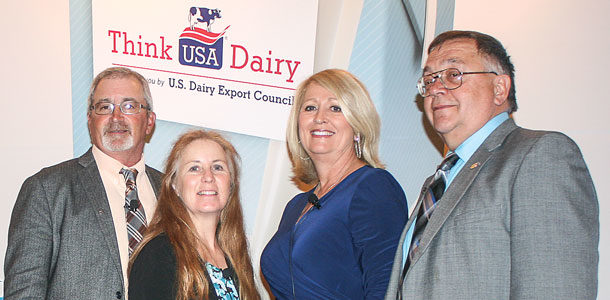I had the opportunity to travel to Singapore and Vietnam with the U.S. Dairy Export Council April 13-22. Our travel group consisted of two council staff members, four Dairy Management Inc. board members (who are also dairy farmers), a USDA representative and two dairy trade media reporters, including me.
In Singapore, the council put on a U.S. Dairy Business Conference for buyers across Southeast Asia. While the conference mostly focused on U.S. dairy products, a few speakers discussed consumer trends in the U.S., noting that many Asian countries were beginning to adopt some of the U.S. consumers’ preferences.Along with the conference, our Singapore stay included a tour and presentation at Leprino Foods’ new facility.

Our group then traveled to Vietnam to attend Food and Hotel Vietnam, a trade show showcasing trends in consumption and hospitality. Our trip also included a tour of Vinamilk’s new processing facility, completed in 2013.
In both countries, our group toured grocery stores and outdoor markets to get an idea of the type of dairy products being sold and consumed.
I’ve condensed my notes from the 10-day trip into a Reader’s Digest version. What struck me most from the experience is that the future of U.S. exports is mostly educated guesses. No one’s quite sure what will happen as the European Union lifts its quota system.

South America is a dark horse, but it has big obstacles to overcome in economic and political instability. From a dairy standpoint, China can’t produce enough milk to meet its own country’s demand, but it’s a powerful force globally. Trade agreements between countries across the globe are in a constant state of flux.
Why does the U.S. careabout Southeast Asia?
Because milk production in the U.S. continues to increase, 80 percent of the U.S. milk supply is going to have to find a home outside our own borders. Mexico is our number one export ally, but Southeast Asia comes in at a close second.
When we talk about exporting to that region, we’re mostly referring to the Association of Southeast Asian Nations (ASEAN), which includes Cambodia, Indonesia, Malaysia, Myanmar, Philippines, Singapore, Thailand and Vietnam. All trade is good to go within that region, but each country has different non-tariff barriers with outside countries.
Thailand, for example, has its own dairy industry that it wants to protect. Singapore’s only hope for dairy products is to import from other countries. But overall, ASEAN can’t supply much milk itself. Just 9 percent of Asia’s dairy supply is produced within the ASEAN region. ASEAN itself is importing 67 percent of its milk demand.
The U.S.’s key markets within Southeast Asia are Indonesia, Philippines, Thailand, Malaysia and Singapore. There’s only 5 million people represented in these countries, but they’re importing a huge amount of product, and they have a lot of manufacturing facilities.
Malaysia is expected to be fully developed by 2020 and likely wealthy. Anticipated product lines include UHT recombined milk and sports drinks. Thailand is expected to follow a similar path. Singapore has a more mature cheese market than the other countries.
Traditionally, Vietnam hasn’t been big on dairy consumption, but as U.S. fast food restaurants have entered the market, the country’s cheese consumption has increased. In fact, cheese imports have risen at an average rate of 17 percent each year for the last eight years.

What’s interesting about existing dairy products in that region?
Infant formula is a big deal. Asians have this mentality that if they give their children milk, those children will grow up to be strong athletes. In the U.S., we’re familiar with infant formula, but in Asian countries, this product line extends to what they call “growing up” milk powders (GUM).
This product line is marketed to mothers of infants all the way up to children 5 or 6 years old. The 2008 melamine scandal in China still has lingering effects, and Asian consumers want to know their dairy products are safe. A number of products include a “HACCP-certified” label.
What’s interesting about products we’re trying to get there?
- Cream cheese is seen as the “gateway” cheese for Asian markets. If we can get consumers used to soft, somewhat bland cheeses, we can start to introduce them to harder and more flavorful cheeses.
Luckily, there’s a big bakery market across most Asian countries, so cream cheese is pretty established. But for some Asian countries with little to no cheese experience, we try to start them out with cream cheese and mozzarella.
- In Asian countries with a large Muslim population, it’s important to have halal certification on U.S. products. (Think kosher on products intended for Jewish populations.) Significant Muslim populations would be found in Indonesia, Malaysia and the southern portions of the Philippines and Thailand.
- The U.S. is shifting focus to export-oriented cheese, like Gouda. Gouda is a good ingredient cheese and is easy to melt. It’s popular for gourmet pizza blends.
- The U.S. is ramping up whole milk powder production. An additional 13,000 metric tons of powder was produced in 2014, a 40 percent increase from 2013. Future powder products from the U.S. could include full-fat milk powders and organic milk powders.
Who are we competingwith in that area?
Australia and New Zealand (Oceania) are the biggest competitors currently. Since dairy production in those countries is mostly seasonal, USDEC reps say one of the U.S.’s biggest advantages is that we can provide a consistent, year-round dairy supply.
That and we can meet growing demand, whereas our competitors may be maxed out. With quotas being lifted in the European Union, that region may be able to pick up some market share. However, USDEC experts say the EU doesn’t have the same capacity to grow feed like the U.S. does.
It was particularly interesting to me that many Asian buyers know the difference between U.S. and Oceania cheese based on the color. Because of the grass-based systems, Oceania mozzarella cheese has a slight yellow tint, whereas the U.S.’s mozzarella is more of a pure white.

What’s the latest in trade agreements?
The USDEC, the Obama administration and a bunch of other global trade supporters are pushing for the House of Representatives to pass Trade Promotion Authority (TPA) legislation. There was a lot of back-and-forth about TPA laws this spring, and the Senate voted in favor of it May 22.
TPA affects all global trade, but proponents are particularly fired up about its impact on the Trans-Pacific Partnership (TPP). TPP would increase dairy exports to countries like Singapore and Vietnam. The U.S. is negotiating this partnership with 11 other countries: Australia, Brunei Darussalam, Canada, Chile, Japan, Malaysia, Mexico, New Zealand, Peru, Singapore and Vietnam.
USDEC and NMPF representatives say TPP will put pressure on our negotiating partners, like Canada and Japan, to make their best offers to importing countries. The U.S. will benefit from that and be able to better respond to the global market demands.
Bottom line
Southeast Asia is growing in population and income, and Western culture is having a huge influence on consumers’ food preferences. It’s basically all good news for the U.S. if we can compete from a price standpoint and make sure they know we can deliver a consistent and quality supply. PD
PHOTOS
PHOTO 1: Four U.S. dairy farmers showcased their operations during a presentation at the U.S. Dairy Business Conference. From left to right: John Brubaker, Idaho; Kima Simonson, Washington; Renae De Jager, California; and Harold Shaulis, Pennsylvania.
PHOTO 2 : USDEC information mission participants take some time for a cheesy photo. From left to right: Margaret Speich and Mark O’Keefe, U.S. Dairy Export Council; John Brubaker, Kima Simonson, Renae De Jager and Harold Shaulis.
PHOTO 3 & 4 : Southeast Asian markets have found dairy success with growing up milk powders intended for children from the infant stage up to 5 years old.
PHOTO 5 : U.S. cheese suppliers had their products on display and available for sampling at the Food & Hotel Vietnam trade show.
PHOTO 6 : Wall’s ice cream is a Unilever brand based in the United Kingdom. This product, found at a Vietnamese supermarket, is marketed to the Asian population. It’s a Neapolitan-style ice cream but instead of vanilla, chocolate and strawberry, it’s matcha green tea, salacider (a popular Asian red soda) and milk tea.
PHOTO 7 : A Vietnamese woman sells meat at an outdoor market in Ho Chi Minh City. Photos by Emily Caldwell.

-
Emily Caldwell
- Editor
- Progressive Dairyman
- Email Emily Caldwell







